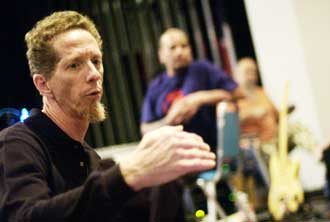Apparattii scores with improvised film and music
Since the beginning of moving pictures, music has played an integral role in filmic experience. The transition from silent films, with improvised or arbitrary live musical accompaniment, to “talkies,” with specifically integrated musical ideas, provided filmmakers the ability to control the emotive and narrative direction of their films. Yet, whether big-budget Hollywood feature or non-narrative experimental montage, the essence of film can be distilled down to the elements of sound and image. How meaning is derived or interpreted from those elements is complex, and the focus of musical supergroup Apparatii’s latest improvisational endeavors.
| PseudoBuddha’s Bobdog Catlin, right, and John Cortez are joined by James Cobb and James Sidlo in an improvised performance accompanying a film by Kevin Casy. (Photos by Mark Greenberg) |
The concept of Wednesday’s performance at Our Lady of the Lake’s Thiry Auditorium was to pair a largely improvised musical score with a 50-minute montage by film artists Kevin Casy and Michael Thomas. This was no soundtrack in the typical sense: Given a familiarity with each other’s work, the musicians hadn’t seen the film and the filmmakers hadn’t heard the score. Aside from a basic sketch of the overall format of the piece, there were no preconceived notions of narrative, emotional content, or what and how meaning might emerge from the fusion. The result was a compelling, intuitive, and highly subjective set of associative interpretations that differed, I suspect, for everyone engaged in the experience.
It’s no surprise that Apparatii should decide to explore musical-visual connections. Visual artist and musician James Cobb is naturally inclined toward both mediums, supported in full by cohorts Bobdog Catlin, John Cortez, and James Sidlo. Comprised of avid connoisseurs of film music, the group was a natural choice to provide the “soundtrack” for two screenings of F.W. Murnau’s 1922 classic Nosferatu last year. Intrigued by the possibilities of sound and image, Cobb says, “There is often a unique aural spatiality to the music created for film, and the music’s role in helping to make meaning often instills it with a heightened atmospheric richness. There’s an undeniable synesthesia that operates when visuals and music are working to inform simultaneously.” Wednesday’s performance bore out this idea.
| At left, James Cobb answers questions from the audience. |
The film, culled from stock images, ranged from geological and atmospheric formations to flocks of birds in flight, urban traffic patterns, abstract and classic cartoon animation, and film trailers and TV images from the ’70s. Film speed and pacing were altered during the performance to coincide with musical cadences, tempos, and overall melodic flow. With purely associative cues, the imagery gave visual focus to the music.
The score combined pre-recorded instrumental and found-sound loops with acoustic and amplified live performance, and was loosely organized into five movements. Apparattii sketched out scaffolding such as duration, tempo, key signature, instrumentation, and some chord structures and melodic fragments beforehand, but the rest was improvised. Armed with laptops, woodwinds, an iMac, a cello, electric bass, digital processors, and a Tibetan singing bowl, Apparatii doesn’t use electronic media self-consciously. It’s simply an extension of their improvisational tools.
Thiry’s large scale suited the big, amplified, organically evolving sound, with an adequately large projection screen to dominate the visual space. With these essentials in place, Apparatii is pursuing future projects and hopes to incorporate original film footage. It’s a worthwhile pursuit. For all the technological advances in the past 100 years or so of film history, Apparatii has brought the idea of improvisational film music accompaniment full circle, with plenty of room to evolve. •
Apparatii will perform the score at the Wiggle Room on Friday, April 14.



